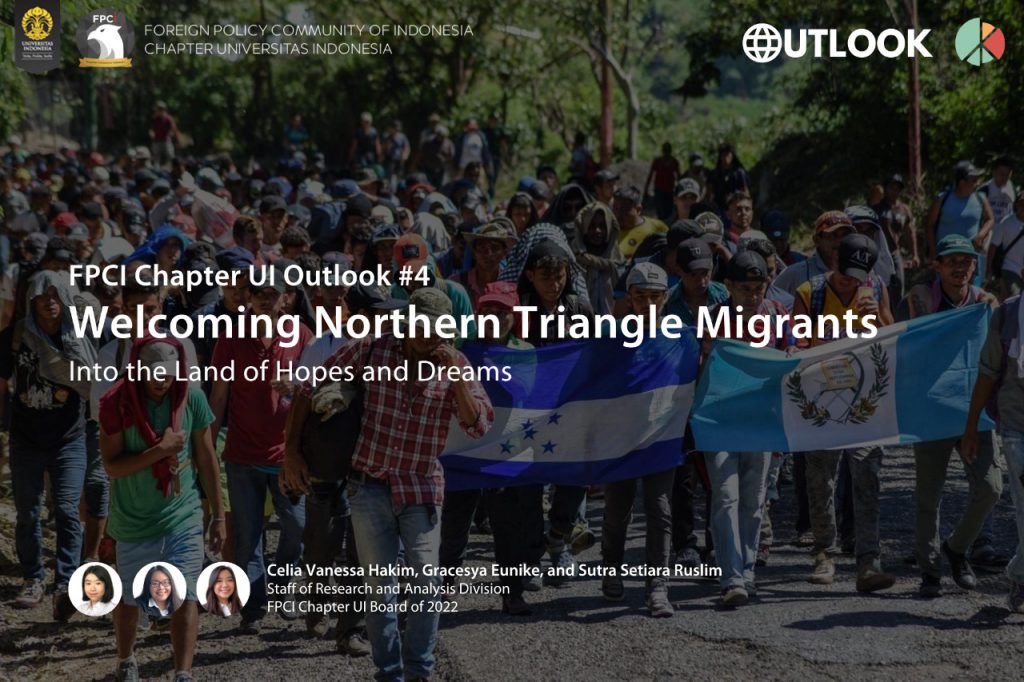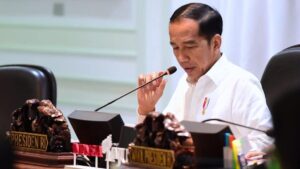Welcoming Northern Triangle Migrants Into the Land of Dream and Hopes

Illustration of FPCI UI
Article 28 of the Universal Declaration of Human Rights states that “everyone is entitled to a social and international order in which the rights and freedoms set forth in this Declaration can be fully realized”. Unfortunately, not everyone is privileged enough to have this mandate fulfilled in their lives. The economic hardship that leads to chronic violence occurring in their own country has forced numerous citizens to relocate to other states where they can enjoy better living conditions. This condition concretely happened in Central America, specifically in the Northern Triangle region, where a massive amount of people migrated voluntarily to improve their lives in another country (UNHCR, 2016).
The Northern Triangle refers to El Salvador, Guatemala, and Honduras–a collection of countries located in Central America. The term “Northern Triangle” existed because of commercial purposes and the name became popular after a signed Free Trade Agreement with Mexico (Chavez & Avalos, 2014). Unfortunately, today, this region is popular for its endemic violence that puts its residents under prolonged suffering. The chronic violences that occur in this region are homicide, infiltration of government institutions to block trade routes to Central America by transnational criminal organizations, criminal gangs like Mara Salvatrucha and the 18th Street Gang, and impulsive sexual and gender-based violence (Congressional Research Service, 2022).
The aforementioned dire conditions in Northern Triangle have led an average of 407.000 people to leave the region each year from 2018 to 2021 (Congressional Research Service, 2022). Some of these people migrated to other parts of Latin America or Europe, but the majority chose to go to the United States via Mexico (Cheatham & Roy, 2022). By fact, about 17% of the migrants were found to be unaccompanied children, 39% were traveling with family members, and 45% were single adults (Cheatham & Roy, 2021). Even though US Border Patrol apprehended massive numbers of those individuals under Title 8 of the US Code (Immigration) and expelled them under Title 42 of the US Code (Public Health), there are still few who have managed to find a home in said “Land of Hope and Dreams”.
The Status Quo of the Migrant’s Citizenship and Rights
Leaving their home to rebuild their life in the newfound asylum surely does not come easy. For migrants who have successfully crossed the border and luckily found shelter in the US, their citizenship status does not automatically come along. In 2015, there were about 725.000 of unauthorized immigrants from El Salvador, 550.000 from Guatemala and 375.000 from Honduras, making Northern Triangle nations the top among other countries for the sheer number of unauthorized migrant populations (Cohn et al., 2017). These unauthorized immigrants from the Northern Triangle then received temporary permission to live and work in the US under two federal programs with uncertain futures, namely the Temporary Protected Status (TPS) and the Deferred Action for Childhood Arrivals (DACA).
TPS is a program that allows assistance based on natural catastrophes in migrants’ home countries. While TPS does not automatically make individuals eligible for a permanent residence or US citizenship, some may apply for permanent lawful status (Cohn et al., 2019). Meanwhile DACA is an American immigration policy that allows illegal immigrants brought into the country as children, who if meet the given guidelines, to have a two-year deferred period of deportation and also to obtain a work permit in the US (US Citizenship and Immigration Services, 2021). In September 2017, nearly 60.000 of young unauthorized immigrants from the three countries received work permits and relief from deportation under the federal DACA program.
However, people who adhere to the aforementioned programs still have concern, let alone those who did not meet the prerequisites to even receive any assistance. Those migrants are mostly concerned about their survival and social welfare because their legality often prevents them from getting access to health, education, and security. Based on an augmented report in 2015 by American Community Survey, the educational attainment of migrants from the Northern Triangle is below other US migrants. While 48% of legal migrants from the Northern Triangle have completed high school, 60% of unauthorized migrants from this region have not (Pew Research Center, 2017). Among the 2015 Northern Triangle migrants, 27% had a high school diploma or equivalent and no higher education, while 11% had some college education or a two-year degree and 7% had a bachelor’s degree or higher (Cohn et al., 2017).
Noticing the deplorable statistics, for the last twenty years, the US has attempted to help those countries regarding their emigration flow issues by enhancing their social and economic capability, along with improving their domestic security. However, no significant changes have occured. Knowing this, US policies have been going through several transformations to create a more effective mechanism for reconstructing the Northern Triangle (Cheatham & Roy, 2022).
US Approaches to the Northern Triangle
During Barack Obama’s presidency, his administration initiated the Central America Regional Security Initiative (CARSI). It was budgeted for more than US$2 billion to aid the region’s law enforcement, counternarcotics agencies, and justice systems. After a 2014 migration flow escalation from the region, Obama’s administration partnered with Northern Triangle governments on anti-smuggling operations and socialization intended to deter future migration attempts. After Mexico, the Northern Triangle countries were the largest shares of the Obama-era deportations. Hence, the shares represented how there was still a recurring problem that the Obama administration lacked in responding to (Cheatham & Roy, 2022).
Additionally, during Donald Trump’s presidency, he created a major setback by tightening border security. This was proven from the zero-tolerance policy that criminally prosecuted all adults entering the US illegally. The policy got criticized because it deployed troops and diverted funds to secure the border, negotiated asylum deals with Mexico and Northern Triangle countries to send immigrants back from the US, and separated thousands of immigrant children from their parents. Furthermore, Trump also ended the TPS and began to withhold most aid to the Northern Triangle in 2019 due to the region’s failure in pushing down migration (Cheatham & Roy, 2022).
During Joe Biden’s presidency, several attempts have been taken to solve this issue. These attempts are; canceling the asylum deals, raising the refugee cap to 125.000, reserving temporary visas for workers from the region, and reinforcing Obama’s administration program allowing eligible children to join their parents already living in the US. Biden also launched a $4 billion plan for the region to tackle the root causes of migration. He also built campaigns and socializations to discourage irregular migration, instructed the Northern Triangle countries’ officials to disrupt migrant flows, and continued to expel migrants except for unaccompanied children, some families, and adults (Cheatham & Roy, 2022).
In March 2021, a special envoy for the Northern Triangle, Ricardo Zuniga, and Vice President Kamala Harris led a diplomacy partnership to the US’ Southern border by focusing on border enforcement, stimulating private sector investment, and giving grassroots support to the civil society. Kamala Harris’s involvement has led to a promising result in pushing a coalition of US corporates, nongovernmental organizations, and foundation leaders to invest in impoverished rural and urban communities in the region. Her contribution to the Northern Triangle has three specific objectives: (1) to increase GDP per capita to more than $8.000; (2) to open more than three million job opportunities; and (3) to reduce the poverty rate by 15%. However, these goals are set for a decade rather than a single administration, considering how challenging and complicated the issues are (Schneider, 2021).
The Fault in US Approaches
Accordingly, there are problems of how the US takes charge of the Northern Triangle. First, there was a major setback during Trump’s administration, especially during the Covid-19 pandemic. Due to major withdrawal of economic aid, governance supervision, and border permission, people from the Northern Triangle countries suffered from economic loss, a high rate of criminal activities, and a lack of good and coherent government. The domino effects of Trump’s administration still last until today.
Secondly, the deportation and border restriction policy are taking away the chance of the Northern Triangle migrants to pursue better living conditions. The last three administrations have all agreed upon the framework of immigrant deportation and border restriction, which may harm the livelihood quality of migrants depending on the region’s situation. This is why a lot of people in the Northern Triangle do not have access to a sufficient way of living because they are not facilitated by their governments. Thus, oftentimes, the only way for them to access a better life is to migrate to other countries.
Thirdly, despite the promising improvements in handling the issue, the current presidency lacks to create an immediate and urgent result. For instance, the goals are set in a decade, which means that during these years, people are still likely to suffer the same problem. Even after a decade, there will still be a lot of problems to work on because the goals that they set aim to decrease, but not holistically solve the problems. It will also become a major problem in sustaining their goals if a different administration turns out to be elected in the next US election. As what happened during the transition from Obama to Trump, the current framework that Kamala Harris uses might not be used in the future and her three objectives might not be achievable. This may result in the failed attempt to help the Northern Triangle communities in which prolongs their suffering.
In conclusion, what the Northern Triangle communities have experienced for years is structurally destructive to all of its residents. The daily sufferings that they have to go through, be it criminal activities or economic struggles should end once and for all, but most importantly, should be handled in a fast and holistic response. Although there are some improvements regarding the way they handle the problem, what the US has done for the last few administrations is undeniably far from enough to create a satisfactory result. It is hoped that the US will continue to improve its framework to make sure that the Northern Triangle communities can access better living conditions and in turn, live optimally as humans should, as expressed in Article 28 of the Universal Declaration of Human Rights.
References:
Chavez, S., & Avaloz, J. (2014, April 23). The Northern Triangle: The Countries That Don’t Cry for Their Dead. InSight Crime. Retrieved August 23, 2022, from https://insightcrime.org/news/analysis/the-northern-triangle-the-countries-that-dont-cry-for-their-dead/
Cheatham, A., & Roy, D. (2021, July 1). Central America’s Turbulent Northern Triangle. Council on Foreign Relations; CFR. https://www.cfr.org/backgrounder/central-americas-turbulent-northern-triangle
Cohn, D., Passel, J. S., & Bialik, K. (2019, November 27). Many immigrants with Temporary Protected Status Face Uncertain Future in U.S. Pew Research Center. https://www.pewresearch.org/fact-tank/2019/11/27/immigrants-temporary-protected-status-in-us/
Cohn, D., Passel, J. S., & Gonzalez-Barrera, A. (2017, December 7). Rise in U.S. Immigrants From El Salvador, Guatemala and Honduras Outpaces Growth From Elsewhere. Pew Research Center. https://www.pewresearch.org/hispanic/2017/12/07/recent-trends-in-northern-triangle-immigration/
Gonzales-Barrera, A. (2017, June 29). Mexican Lawful Immigrants Among the Least Likely to Become U.S. Citizens. Pew Research Center. https://www.pewresearch.org/hispanic/2017/06/29/why-mexican-lawful-immigrants-have-not-naturalized/
Meyer, P. J. (2022). Central American Migration: Root Causes and U.S. Policy. In https://crsreports.congress.gov (p. 1). The Congressional Research Service. https://sgp.fas.org/crs/row/IF11151.pdf
Pew Research Center. (2017). A majority of Northern Triangle immigrants have not finished high school. Pew Research Center. https://www.pewresearch.org/hispanic/2017/12/07/geography-and-characteristics-of-northern-triangle-immigrants/pg_2017-12-7_central-american-immigration_2-04/
Preserving and Fortifying Deferred Action for Childhood Arrivals[DACA]. (2021, January 21). The White House. https://www.whitehouse.gov/briefing-room/presidential-actions/2021/01/20/preserving-and-fortifying-deferred-action-for-childhood-arrivals-daca/
Schneider, M. L. (2021, July 20). Six months on: Changes in U.S. policy toward the northern triangle. Retrieved August 4, 2022, from https://www.csis.org/analysis/six-months-changes-us-policy-toward-northern-triangle
The United Nations High Commissioner for Refugees [UNHCR]. (2016, July 11). UNHCR viewpoint: ‘Refugee’ or ‘migrant’ — Which is right? UNHCR: The UN Refugee Agency. https://www.unhcr.org/news/latest/2016/7/55df0e556/unhcr-viewpoint-refugee-migrant-right.html
The United States Citizenship and Immigration Services. (2021, July 19). Consideration of Deferred Action for Childhood Arrivals (DACA) | USCIS. Www.uscis.gov; USCIS. https://www.uscis.gov/DACA
United Nations. Universal Declaration of Human Rights. https://www.un.org/en/about-us/universal-declaration-of-human-rights#:~:text=Drafted%20by%20representatives%20with%20different,all%20peoples%20and%20all%20nations.
Celia Vanessa Hakim, Gracesya Eunike, and Sutra Setiara Ruslim are staffs of Research and Analysis Division FPCI Chapter UI Board of 2022





